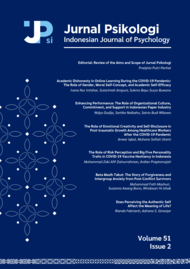Pengujian Validitas Konstruk Kriteria Kecanduan Internet
Helly P. Soetjipto(1*)
(1)
(*) Corresponding Author
Abstract
This research is used to explore the internet addiction concept which developed by Young who used the internet consumer subject in Yogyakarta. 124 subjects (63 male a and 61 females) within 14‐35 years old, most of them were students, only 3 subjects who have worked. They catagorized as existing user because they had the criteria mentioned by Grohol (1999). Confirmatory factor analysis became the basic for construct validity testing. AMOS fifth version (student version) was used to analyze the data. There are 2 factors which was tested in structural equation model, they are main factor and additional factor. The main factor consists of 5 items and additional factor consists of 2 items.
The result showed that structural equation model did not have the weakness which called Heywood Case, because there was 1 factor which consists of only 2 items. There are 2 modification suggested. The first modification model has discrepancy index 9.782 (p>0.05) and the second modification model has 11. 452 (p>0.05).
Keywords: construct validity, internet addiction
The result showed that structural equation model did not have the weakness which called Heywood Case, because there was 1 factor which consists of only 2 items. There are 2 modification suggested. The first modification model has discrepancy index 9.782 (p>0.05) and the second modification model has 11. 452 (p>0.05).
Keywords: construct validity, internet addiction
Full Text:
PDFArticle Metrics
Refbacks
- There are currently no refbacks.
Copyright (c)
Recent Issues
 |  |  |  | ||||
| Vol 51 Issue 2 (2024) Page 120-230 | Vol 51 Issue 1 (2024) Page 1-119 | Vol 50 Issue 3 (2023) Page 219-332 | Vol 50 Issue 2 (2023) Page 125-218 |
| Published by Faculty of Psychology, Universitas Gadjah Mada, Indonesia Building D-6th, Floor No. D-606. Jl. Sosio Humaniora No. 1, Bulaksumur Yogyakarta, 55281 Email: jurnalpsikologi@ugm.ac.id Phone/whatsApp: +6281125210175 |











